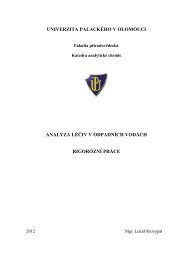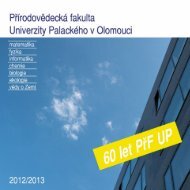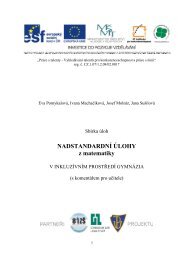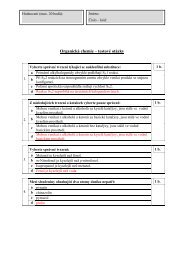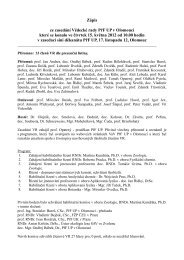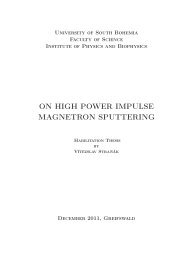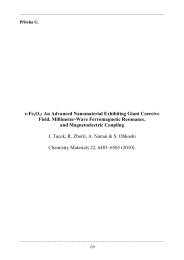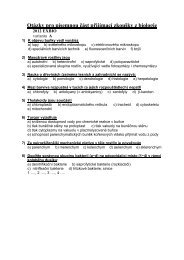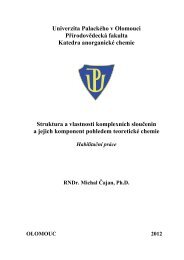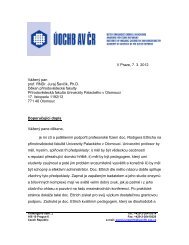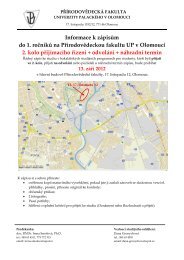A comparative structural analysis of direct and indirect shoot ...
A comparative structural analysis of direct and indirect shoot ...
A comparative structural analysis of direct and indirect shoot ...
Create successful ePaper yourself
Turn your PDF publications into a flip-book with our unique Google optimized e-Paper software.
4208 Illéš et al.<br />
Fig. 7. Internalization <strong>of</strong> aluminium in specific developmental zones <strong>of</strong> pulse-treated Arabidopsis roots with 50 lM AlCl 3 for 30 min. Roots were<br />
pretreated with 4 lM FM4-64 <strong>and</strong> stained with morin after washing out the aluminium. In the meristematic cells (A) <strong>and</strong> the cells <strong>of</strong> distal transition zone<br />
(B) aluminium was internalized <strong>and</strong> accumulated in vacuolar compartments after 2 h 50 min <strong>of</strong> recovery. Tonoplast was labelled red with FM4-64 <strong>and</strong><br />
the aluminium-containing lumen <strong>of</strong> the vacuole was stained green with morin. In the proximal transition zone (C) there was no uptake <strong>of</strong> aluminium even<br />
3 h 10 min after the end <strong>of</strong> the treatment; aluminium was not accumulated in the vacuoles <strong>and</strong> could be detected only in the apoplast. Representative <strong>of</strong><br />
five seedlings per treatment. Bar¼10 lm.<br />
recovery <strong>and</strong> careful visualization <strong>of</strong> its fluorescence<br />
allowed the time-course <strong>of</strong> aluminium internalization to<br />
be studied at low, non-lethal concentrations even in the<br />
most sensitive cells <strong>of</strong> DTZ.<br />
Cells <strong>of</strong> various root developmental zones have<br />
different sensitivity to aluminium <strong>and</strong> show<br />
specific patterns <strong>of</strong> recovery<br />
The effect <strong>of</strong> aluminium on root cells became evident by<br />
rapid changes <strong>of</strong> the electrical membrane potential, which<br />
were different in the cells <strong>of</strong> various developmental stages.<br />
The root apex consists <strong>of</strong> distinct developmental zones<br />
including the cell division zone (meristem), two zones <strong>of</strong><br />
preparation for rapid cell expansion (DTZ <strong>and</strong> PTZ), followed<br />
by the actual zone <strong>of</strong> rapid cell elongation (Baluška<br />
et al., 1990, 1994, 1996; Ishikawa <strong>and</strong> Evans, 1993; Verbelen<br />
et al., 2006). Aluminium caused the rapid depolarization <strong>of</strong><br />
the plasma membrane electro-potential (E m ) in the cells <strong>of</strong><br />
both the DTZ <strong>and</strong> PTZ. The extent <strong>of</strong> depolarization, however,<br />
was much greater in the more sensitive DTZ. This is<br />
in accordance with the observations by Sivaguru <strong>and</strong> Horst<br />
(1998), Horst et al. (1999), <strong>and</strong> Sivaguru et al. (1999,<br />
2003a), who described a different sensitivity <strong>of</strong> the cells<br />
in different developmental zones. This clearly indicates that<br />
the extent <strong>of</strong> the aluminium sensitivity as a function <strong>of</strong> cellular<br />
developmental stages should be taken into consideration.<br />
Concerning recovery from aluminium stress, removing<br />
free aluminium from the medium was followed by full<br />
regeneration <strong>of</strong> the E m values. Hence, the changes in<br />
electrophysiological properties <strong>of</strong> the plasma membrane




